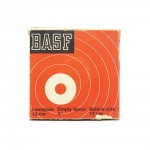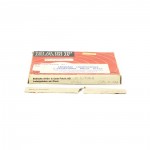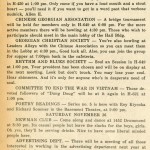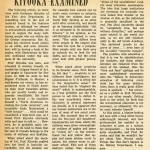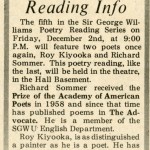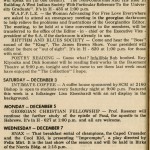Introducer- Stanton Hoffman
00:00:00.00
On behalf of the Poetry Reading Committee of Sir George Williams University I wish to welcome you to this, the fifth, in a series of poetry readings, given at this University during 1966-67. Tonight there will be readings by two poets living in Montreal, and members of the faculty of this University. There will be a fifteen minute intermission in between each reading. Roy Kiyooka was born in Moose Jaw Saskatchewan, he studied at the Provincial Institute of Technology and Art, the Instituto Allende in Mexico, and the University of Saskatchewan Emma Lake Workshops. He has had one-man exhibitions in Edmonton, Calgary, San Miguel D'Allende, Saskatoon, Regina, Toronto, Vancouver, Victoria, New York City and Montreal. He exhibited at the Sao Paulo Biennial, where he was one of four painters representing Canada, and where he received honourable mention and a Silver Medal. His most recent show was held last month at the Lane/Ling [spelling?] Galleries in Toronto. In 1964, his first volume of poems, Kiyoto Airs, was published by the Periwinkle Press in Vancouver. His second volume, Nevertheless, These Eyes is being published this month, in Montreal by Bev Leech. Ladies and Gentlemen, Mr. Roy Kiyooka.
Roy Kiyooka
00:01:25.58
[CUT.].start off this evening by reading a few poems from my earlier book, the one that Stan mentioned. These poems were written as a result of a summer in Japan, and they are very much occasional poems, they address themselves to the particular occasion of having been there, and they were meant in part to account for that experience of having been there, to my numerable friends in Vancouver. I'll begin by reading three very short little poems, they all relate to what should we call it, the various contexts in which I saw the sculptured image of the Buddha. The first one is called "Waiting Out the Rain".
Annotation
00:02:51.26
Reads "Waiting Out the Rain".
Roy Kiyooka
00:03:13.65
This is "Buddha in the Garden". Again, very brief.
Annotation
00:03:23.43
Reads "Buddha in the Garden".
Roy Kiyooka
00:03:47.99
This is "Sunday at the Temple".
Annotation
00:03:53.40
Reads "Sunday at the Temple".
Roy Kiyooka
00:04:20.22
And this is the image of a Buddha seen in the Kiyoto Museum, a reclining figure.
Annotation
00:04:30.24
Reads first line "Hovering, he is hovering, his eyes closed..."
Roy Kiyooka
00:05:01.82
Now the next is a sequence of four little poems, very much like the traditional Japanese poems called the Haiku. This is a sequence, the title of which is "The Stone Garden of Ryoanji". The first one goes like this:
Annotation
00:05:27.51
Reads first line "1. They whisper..."
Annotation
00:05:45.13
Reads first line "2. The boards..."
Annotation
00:06:07.54
Reads first line "3. White sand..."
Annotation
00:06:24.62
Reads first line "4. When each stone..."
Roy Kiyooka
00:06:49.49
Now this one is called "Children's Shrine", throughout most of the cities and towns and villages all over Japan you'll find way-side shrines, they're frequently just built into the wall in a very narrow street and people on whatever religious occasion come to worship there, this is a shrine particularly for children. And it goes like this:
Annotation
00:07:24.19
Reads "Children's Shrine".
Roy Kiyooka
00:08:41.94
Well this is rather a long sequence, once more very short poems, there are eleven of them, and the title of the sequence is simply "Higashiyama", now 'higashiyama' means, in English, 'east mountain'.
Annotation
00:09:22.00
Reads "1. Kneeling, she brought..."
Annotation
00:09:39.23
Reads "2. Oh the white pigeon..."
Annotation
00:10:04.28
Reads "3. You rise up..."
Annotation
00:10:20.97
Reads "4. She called Higashiyama..."
Annotation
00:10:38.58
Reads "5. Small comfort..."
Annotation
00:10:54.39
Reads "6. On Higashiyama..."
Annotation
00:11:13.54
Reads "7. Tonight, Higashiyama..."
Annotation
00:11:38.93
Reads "8. Beyond Higashiyama..."
Annotation
00:11:55.45
Reads "9. Put stone upon stone..."
Annotation
00:12:17.77
Reads "10. Tell me, Cid..."
Annotation
00:12:43.47
Reads "11. I have left..."
Roy Kiyooka
00:13:01.00
Well I'll go on to the last poem in the book, this is an attempt, as it were, to sum up the varied experiences that I had there. The poem is called "Itinerary of a View".
Annotation
00:13:29.91
Reads "Itinerary of a View".
Roy Kiyooka
00:17:07.19
I think I need to say a few words about this next group of poems, they were, they're from the book that I am having done at the moment, I started these poems in June 1965 in Montreal when I first came here, I don't know how to tell you this, except that at the time I came, I stayed with Alfred Pinsky, or rather I stayed at his home, at his invitation, while I was looking for a place to live. Now, this took me about two weeks, it was very hot, and in the evenings I used to go through his library and pick up things and scanned them. One evening I came across this book, which was a biography of the English painter, Stanley Spencer. Spencer, we could say is perhaps the co-partner in the origin and the form and the content of this book. The book is in three parts, the first part is called the mirror, "The Song the Mirror Sang at Midnight", and it is prefaced by a quotation from Spencer, which goes like this: "I am meeting you all the time, and sending my longing for you into chaos, into the darkness, beyond these walls". I may add that these poems, likewise, are on the whole, very brief, though some are longer.
Annotation
00:19:31.74
Reads first line "1. Climbing into the mirror..."
Annotation
00:20:34.97
Reads first line "2. Behind my eyes..."
Annotation
00:21:55.13
Reads first line "3. The image of her..."
Annotation
00:22:49.36
Reads first line "4. At least the shape of it..."
Annotation
00:23:23.50
Reads first line "5. Since you asked me..."
Annotation
00:24:18.59
Reads first line "6. The distance between..."
Annotation
00:24:46.28
Reads first line "7. Munch, stuffed her scream..."
Annotation
00:25:24.56
Reads first line "8. My hand covets..."
Annotation
00:25:51.06
Reads first line "9. The other face..."
Annotation
00:26:27.82
Reads first line "10. Turning away from the mirror..."
Annotation
00:27:02.17
Reads first line "11. The mirror that once reflected..."
Annotation
00:27:26.07
Reads first line "12. In all this space..."
Annotation
00:28:06.11
Reads first line "13. In a room..."
Annotation
00:28:36.89
Reads first line "14. It is the vision of her..."
Annotation
00:29:21.70
Reads first line "15. Now, other faces appear..."
Roy Kiyooka
00:30:05.51
The last one in this section.
Annotation
00:30:11.71
Reads first line "Who, among you, can say what..."
Roy Kiyooka
00:30:53.57
There's a terrible draft coming in from the back, I think you're right Dick, we're going to end up with arthritic ankles. Well, this is the second section, and it is called "The Proposal". Once more, prefaced with a remark from Stanley Spencer, a very beautiful one. They are set down, as I found them in the book, I have used them in the context of this section of the book and these four poems, taken from his writings are meant to define certain of her attributes. Now I have given a title to each one of these four poems, and I hope they will clarify the context in which they belong here. "Portrait of the Beloved".
Annotation
00:32:06.87
Reads "Portrait of the Beloved".
Roy Kiyooka
00:32:56.83
This I called "The Marriage".
Annotation
00:33:05.68
Reads "The Marriage".
Roy Kiyooka
00:33:37.13
This is called "The Separation".
Annotation
00:33:45.27
Reads "The Separation".
Roy Kiyooka
00:34:07.38
And this, is "Her Apotheosis".
Annotation
00:34:17.98
Reads "Her Apotheosis".
Roy Kiyooka
00:35:23.32
That incidentally, is a description he wrote to a friend about a painting that he in fact had made. From your response, I gathered, it has a comic element, but I don't think that he himself made it that way. [laughs.]
Annotation
00:36:05.44
Reads first line "The grotesque flash..."
Annotation
00:38:04.73
Reads first line "The beloved is resilient..."
Roy Kiyooka
00:38:36.97
The first stanza of this two-stanza poem is from Spencer, once again.
Annotation
00:38:43.51
Reads first line "The women say what I like..."
Roy Kiyooka
00:39:34.05
The reference in this poem is to an exemplary sculptor who died many years ago, who obsessionally sculpted the human female form, his name is Gaston Lachaise.
Annotation
00:40:02.45
Reads first line "Gaston Lachaise..."
Roy Kiyooka
00:40:59.50
The title of this poem is the same as the title of the second section, it's "The Proposal".
Annotation
00:41:14.81
Reads "The Proposal".
Roy Kiyooka
00:42:27.18
This one is called "The Dance".
Annotation
00:42:33.70
Reads "The Dance".
Roy Kiyooka
00:43:59.93
The title of this poem is called "Her Admonition".
Annotation
00:44:06.26
Reads "Her Admonition".
Roy Kiyooka
00:45:28.00
Now the following five poems are called "Poems of Resurrection".
Annotation
00:45:46.13
Reads first line "The way they lie there..."
Roy Kiyooka
00:47:27.24
Second "Resurrection" poem.
Annotation
00:47:28.96
Reads first line "The fallen have risen..."
Annotation
00:48:33.17
Reads first line "Number 3. The moon raises tides..."
Annotation
00:49:07.02
Reads first line "4. Stanley Spencer painted..."
Roy Kiyooka
00:49:49.28
The last Resurrection poem, which concludes with a very brief, two-line coda.
Annotation
00:50:01.31
Reads first line "The resurrected flesh..."
Roy Kiyooka
00:50:51.38
Now, the second to last poem is called "The Visitation".
Annotation
00:51:16.11
Reads "The Visitation".
Roy Kiyooka
00:53:14.24
And finally,
Annotation
00:53:22.15
Reads first line "What the beloved said..."
Annotation
00:53:56.30
Well, this is the final section. This is called "Nevertheless, These Eyes" and briefly, and again from Spencer, a preface that goes like this: "I am on this side of angels and dirt".
Annotation
00:55:25.80
Reads "Nevertheless, These Eyes".
Roy Kiyooka
01:00:20.34
And finally, by way of acknowledging the nature of this book.
Annotation
01:00:31.31
Reads first line "The figure in the poems are his..."
Roy Kiyooka
01:00:57.76
Thank you very much...[CUT.].. and I were reading together, decided we should write one for the occasion, so we have each come up with a haiku. This is my haiku, it's especially for Dick. I have in brackets here, "A gentle admonition to the audience following my reading, and preceding his" and it goes like this: "Let the stone tell how /snow-covered in whiteness, /these words, when his words come."
Annotation
01:01:42.65
END OF RECORDING.



